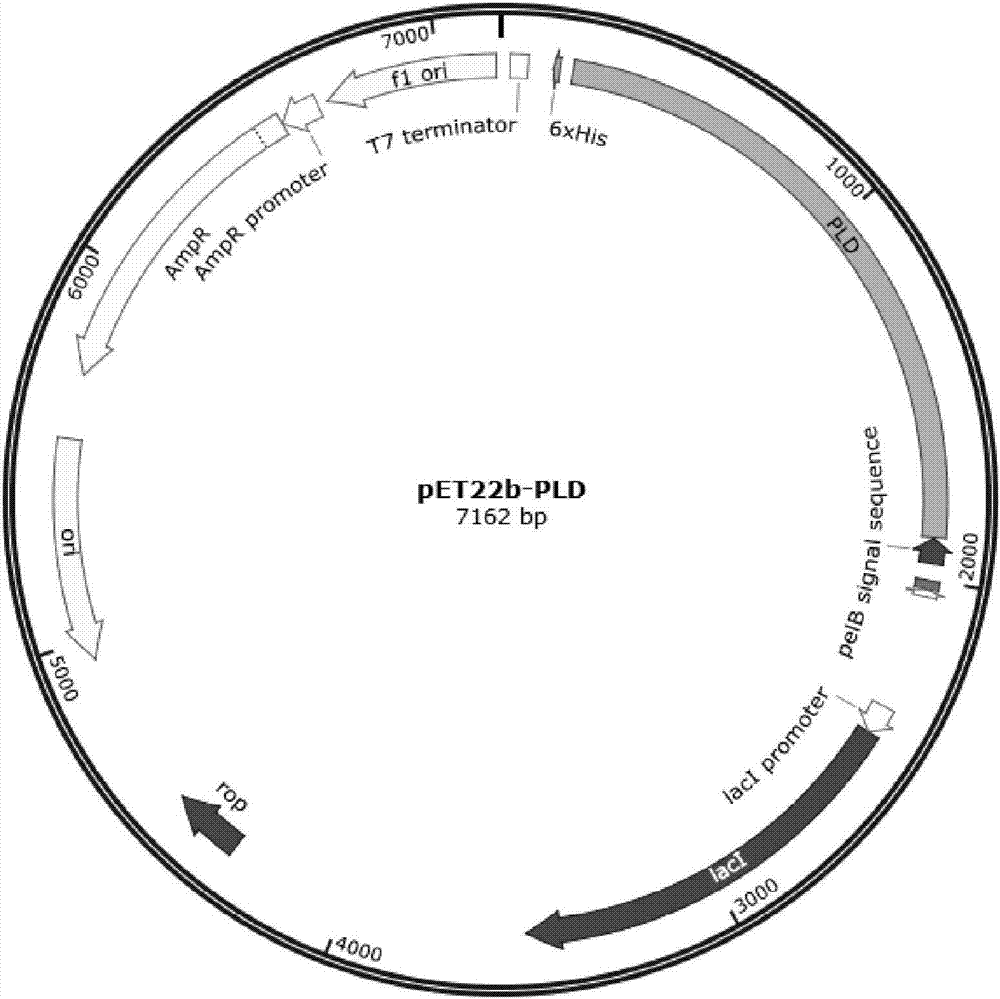Genetically engineered bacteria for producing phospholipase D and construction method and application thereof
A technology of genetically engineered bacteria and construction method, which is applied in the fields of biotechnology and preparation of phosphoester products, can solve the problems of no PLD product, immature PLD, etc., and achieves the effects of low cost, convenient enzyme source and high yield
- Summary
- Abstract
- Description
- Claims
- Application Information
AI Technical Summary
Problems solved by technology
Method used
Image
Examples
Embodiment 1
[0035] Example 1: Construction of recombinant Escherichia coli BL21(DE3)-pET22b-PLD.
[0036] (1) Using the genomic DNA of Streptomyces sp. (strain PMF) as a template to clone the phospholipase gene, the base sequence of which is shown in SEQ ID NO.2;
[0037] (2) Cloning the phospholipase D gene obtained in (1) into the pET-22b(+) expression vector to construct a recombinant expression plasmid;
[0038] (3) The recombinant plasmid obtained in (2) was transformed into Escherichia coli BL21(DE3) competent cells to obtain recombinant Escherichia coli BL21(DE3)-pET22b-PLD1.
Embodiment 2
[0040] The composition of the seed medium is: NaCl 5g / L, peptone 10g / L, yeast powder 5g / L, pH 7.4, sterilized at 121°C for 20min.
[0041] The components of the fermentation medium are: peptone 10g / L, yeast extract 5g / L, NaCl 5g / L, sterilized at 121°C for 20min.
[0042] Inoculate the recombinant Escherichia coli BL21(DE3)-pET22b-PLD1 in the seed medium containing 50mg / mL ampicillin, and culture it in the shake flask at 37°C and 200r / min until the logarithmic growth phase, as the seed liquid; then the seed liquid Inoculate into 100mL fermentation medium containing ampicillin 50mg / mL according to 5% inoculum amount, and culture in shake flask at 37°C and 200r / min until OD 600 =0.6, then add IPTG to a final concentration of 0.05mM, induce culture at 30°C, 200r / min for 12h; centrifuge the fermentation broth at 4°C, 8000r / min for 10min, and take the supernatant to obtain a crude phospholipase D enzyme solution.
[0043]Dissolve lecithin in dichloromethane at a concentration of 10...
Embodiment 3
[0046] Embodiment 3: Phospholipase D gene codon optimization
[0047] (1) Escherichia coli codon optimization was performed on the phospholipase D gene derived from Streptomyces sp. (strain PMF) to obtain the optimized phospholipase D gene, whose sequence is shown in SEQ ID NO.1:
[0048] (2) Cloning the phospholipase D gene obtained in (1) into the pET-22b(+) expression vector to construct a recombinant expression plasmid;
[0049] (3) The recombinant plasmid obtained in (2) was transformed into Escherichia coli BL21(DE3) competent cells to obtain recombinant Escherichia coli BL21(DE3)-pET22b-PLD2.
PUM
 Login to View More
Login to View More Abstract
Description
Claims
Application Information
 Login to View More
Login to View More - R&D
- Intellectual Property
- Life Sciences
- Materials
- Tech Scout
- Unparalleled Data Quality
- Higher Quality Content
- 60% Fewer Hallucinations
Browse by: Latest US Patents, China's latest patents, Technical Efficacy Thesaurus, Application Domain, Technology Topic, Popular Technical Reports.
© 2025 PatSnap. All rights reserved.Legal|Privacy policy|Modern Slavery Act Transparency Statement|Sitemap|About US| Contact US: help@patsnap.com



